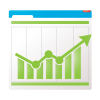Digital Marketing Dictionary – Terms You Should be Aware of

Every business be it small or large wants to invest in digital marketing, and why not? In today’s day and time, it is the best tool to connect with your target audiences and gain immense traffic. But are you aware of these terms pertaining to digital marketing?
We will be covering some widely used and some ‘not so common’ marketing acronyms, and terms related to social media, website optimization, email marketing and content marketing.
By browsing through this partial glossary on marketing, you will be able to understand how the digital marketing world functions and ultimately make the most out of your digital marketing efforts.
So let’s begin…
1. Analytics
The discovery and communication of meaningful patterns in data is referred as analytics. In the marketing context, it is keeping a check on the progress of one’s efforts such as website visitor reports, social media engagement, PPC and so on. All this is done by analyzing the trends, developing actionable insights thereby making well-informed marketing decisions.
2. Bounce Rate
Now there are 2 types of bounce rates, website bounce rate and email bounce rate.
Website Bounce Rate: The % of people who land on your website and leave without clicking on anything else or navigating any other pages is termed as website bounce rate. So higher the bounce rate, poorer the conversion rate as it reflects that users aren’t staying long enough on your page or in a way aren’t finding your content engaging.
Email Bounce Rate: Similarly, the rate at which an email was unable to be delivered to a recipient’s inbox is called as email bounce rate. Out-of-date or purchased email lists may lead to high email bounce rates. Before taking an email address off your list, it is important to distinguish between hard and soft bounces as not all businesses are frauds.
3. Clickthrough Rate (CTR)
Clickthrough rate is the % of your audience that advances from one page of your website to becoming a lead. In simple language, it is the total number of clicks that your page receives divided by the number of times people had to click on that page. For instance: number of pageviews, emails sent, etc.
4. Dynamic Content
Dynamic content is a unique way to display messaging on your website based on the information you already know about the visitor. For instance: you could use Smart CTAs so that first-time visitors will see a personalized CTA (call to action – yet another marketing term which I am sure everyone knows about)
5.Editorial Calendar
It’s basically like a helpful guide to content creation that lets you know what type of content to create, the topics that need to be covered, which audience to target and what is the best time to publish your content. An editorial calendar keeps you more organized and helps you identify anything that’s lacking in your content library. It also lets you know if your efforts are being appreciated by the target audiences or not.
6.Form
The same as what the original term stands for, a document that has to be filled. The only difference here is that it will be a virtual form that will be offered to the visitors of your website, to fill up their information in exchange of your offer. Although a simple form has the potential to convert page visitors into sales leads, it is best advised to seek only that information which you think will be most beneficial in order to effectively follow up and that which will be genuinely required.
7.Google+
Referred to as Google Plus, it is a social platform that lets you join and create circles wherein you can mix and match friends and family members, colleagues and any other people you know. Just like other social networks, you can publish and share content and generate new leads. Being owned by Google itself, Google+ offers tremendous SEO value to content marketers as a result of the growing importance of social sharing in search algorithms.
8.HTML
Short for HyperText Markup Language and at the core of every web page, HTML is a language used to write web pages. It can be rightly called as a technical language that provides the basic structure of the website regardless of the complexities of the site or the number of technologies involved. This technical language is then modified and enhanced by technologies such as CSS and JavaScript.
9.Infographic
Information and graphics when combined together in a visually appealing format becomes an infographic. Infographics allow digital marketers to convey complex concepts in a simple and interesting manner.
10.JavaScript
JavaScript is nothing but a programming language allowing web developers to design interactive sites. Any dynamic responses that you notice on a website are due to JavaScript which adds to a browsers default controls.
Pop-ups, slide-in-calls-to-action, security password creation, interactive games, special effects and check forms are all a result of JavaScript. Mobile apps and server-based applications are also built with the help of JavaScript.




